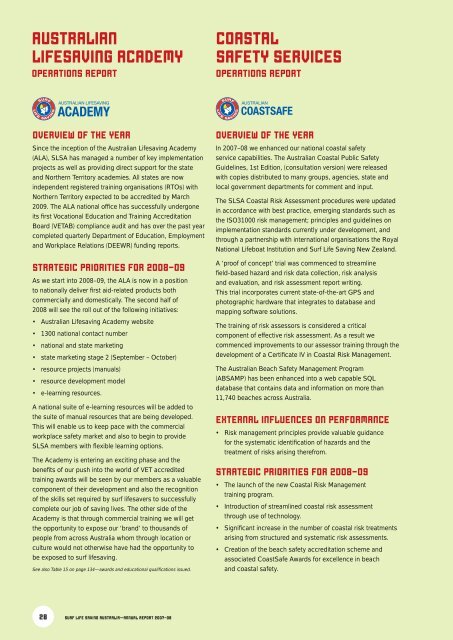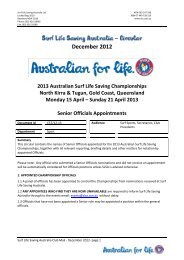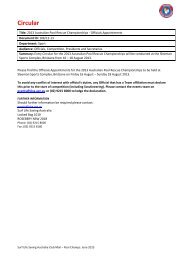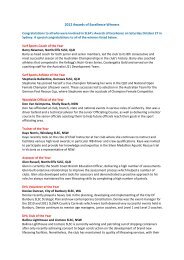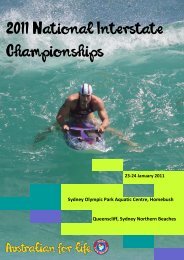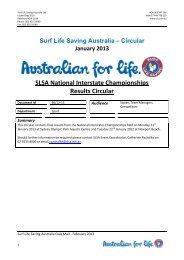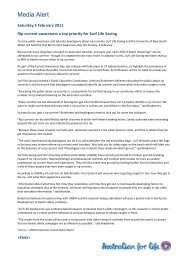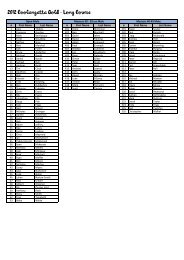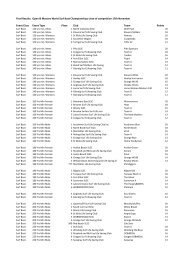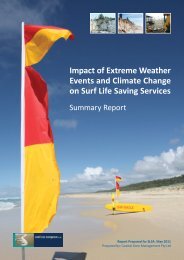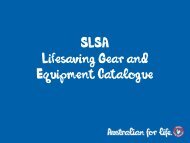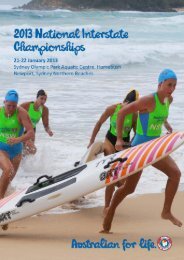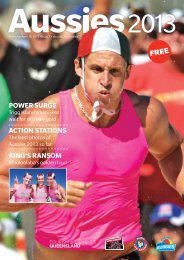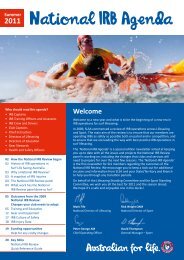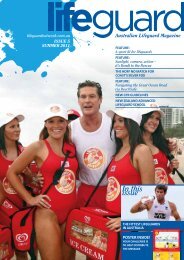SURF LIFE SAVING AUSTRALIA ANNUAL REPORT 2007–08
SURF LIFE SAVING AUSTRALIA ANNUAL REPORT 2007–08
SURF LIFE SAVING AUSTRALIA ANNUAL REPORT 2007–08
- TAGS
- surf
- australia
- annual
- sls.com.au
You also want an ePaper? Increase the reach of your titles
YUMPU automatically turns print PDFs into web optimized ePapers that Google loves.
<strong>AUSTRALIA</strong>N<br />
<strong>LIFE</strong><strong>SAVING</strong> ACADEMY<br />
OPERATIONS <strong>REPORT</strong><br />
OVERVIEW OF THE YEAR<br />
Since the inception of the Australian Lifesaving Academy<br />
(ALA), SLSA has managed a number of key implementation<br />
projects as well as providing direct support for the state<br />
and Northern Territory academies. All states are now<br />
independent registered training organisations (RTOs) with<br />
Northern Territory expected to be accredited by March<br />
2009. The ALA national offi ce has successfully undergone<br />
its fi rst Vocational Education and Training Accreditation<br />
Board (VETAB) compliance audit and has over the past year<br />
completed quarterly Department of Education, Employment<br />
and Workplace Relations (DEEWR) funding reports.<br />
STRATEGIC PRIORITIES FOR 2008–09<br />
As we start into 2008–09, the ALA is now in a position<br />
to nationally deliver fi rst aid-related products both<br />
commercially and domestically. The second half of<br />
2008 will see the roll out of the following initiatives:<br />
• Australian Lifesaving Academy website<br />
• 1300 national contact number<br />
• national and state marketing<br />
• state marketing stage 2 (September – October)<br />
• resource projects (manuals)<br />
• resource development model<br />
• e-learning resources.<br />
A national suite of e-learning resources will be added to<br />
the suite of manual resources that are being developed.<br />
This will enable us to keep pace with the commercial<br />
workplace safety market and also to begin to provide<br />
SLSA members with fl exible learning options.<br />
The Academy is entering an exciting phase and the<br />
benefi ts of our push into the world of VET accredited<br />
training awards will be seen by our members as a valuable<br />
component of their development and also the recognition<br />
of the skills set required by surf lifesavers to successfully<br />
complete our job of saving lives. The other side of the<br />
Academy is that through commercial training we will get<br />
the opportunity to expose our ‘brand’ to thousands of<br />
people from across Australia whom through location or<br />
culture would not otherwise have had the opportunity to<br />
be exposed to surf lifesaving.<br />
See also Table 15 on page 134—awards and educational qualifi cations issued.<br />
28 <strong>SURF</strong> <strong>LIFE</strong> <strong>SAVING</strong> <strong>AUSTRALIA</strong>—<strong>ANNUAL</strong> <strong>REPORT</strong> <strong>2007–08</strong><br />
COASTAL<br />
SAFETY SERVICES<br />
OPERATIONS <strong>REPORT</strong><br />
OVERVIEW OF THE YEAR<br />
In <strong>2007–08</strong> we enhanced our national coastal safety<br />
service capabilities. The Australian Coastal Public Safety<br />
Guidelines, 1st Edition, (consultation version) were released<br />
with copies distributed to many groups, agencies, state and<br />
local government departments for comment and input.<br />
The SLSA Coastal Risk Assessment procedures were updated<br />
in accordance with best practice, emerging standards such as<br />
the ISO31000 risk management; principles and guidelines on<br />
implementation standards currently under development, and<br />
through a partnership with international organisations the Royal<br />
National Lifeboat Institution and Surf Life Saving New Zealand.<br />
A ‘proof of concept’ trial was commenced to streamline<br />
fi eld-based hazard and risk data collection, risk analysis<br />
and evaluation, and risk assessment report writing.<br />
This trial incorporates current state-of-the-art GPS and<br />
photographic hardware that integrates to database and<br />
mapping software solutions.<br />
The training of risk assessors is considered a critical<br />
component of effective risk assessment. As a result we<br />
commenced improvements to our assessor training through the<br />
development of a Certifi cate IV in Coastal Risk Management.<br />
The Australian Beach Safety Management Program<br />
(ABSAMP) has been enhanced into a web capable SQL<br />
database that contains data and information on more than<br />
11,740 beaches across Australia.<br />
EXTERNAL INFLUENCES ON PERFORMANCE<br />
• Risk management principles provide valuable guidance<br />
for the systematic identifi cation of hazards and the<br />
treatment of risks arising therefrom.<br />
STRATEGIC PRIORITIES FOR 2008–09<br />
• The launch of the new Coastal Risk Management<br />
training program.<br />
• Introduction of streamlined coastal risk assessment<br />
through use of technology.<br />
• Signifi cant increase in the number of coastal risk treatments<br />
arising from structured and systematic risk assessments.<br />
• Creation of the beach safety accreditation scheme and<br />
associated CoastSafe Awards for excellence in beach<br />
and coastal safety.


